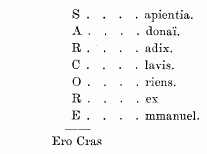Published online by Cambridge University Press: 25 January 2012
In the Book of Common Prayer, in the Kalendar, on December the sixteenth, the words
O Sapientia
occur, which words some have fondly imagined to be the names of a Virgin and Martyr, whom they tried, “with much ingenuity and more ignorance,” to prove one of the companions of S. Ursula; (1) and others have confounded the
O Sapientia
with the mediaeval devotion of the XV. O's, (2) which in no shape or form was, at any time, part of a liturgical service, but merely fifteen private prayers each beginning with the letter 0, as may be seen in Mr. Maskell's Monumenta Ritualia. (3) These XV. O's, however, are of some interest, as they were printed by Caxton in English, and are to be found in most of our Prymers. (3)
page 219 note a In the Kalendar of the Book of Hours of Louis, Duke of Anjou, 1390 (now in the Bibliothèque Rationale, Paris), O Sapientia does occur in the form “Saint Sapience.”
page 222 note a An old English metrical translation of the eight Great O's of the Sarum Breviary is given in the Appended Note (E) to this Paper.
page 223 note a If the first letter after each O, of the Gregorian O's, is read in the inverse order, that is upwards, the words Ero cras are formed, which gives not a little colouring to the words “cras” and “crastina,” which occur eighteen times in the Breviary Services for the Vigil of Christmas in the Roman Breviary.

page 224 note a At times the reading is quia nec prima tui similis visa est, nec habebis sequentem.
page 225 note a In the Dominican Breviary, the O Virgo Virginum is said daily during Advent at Magnificat in the Officium quotidianum Beatœ Mariœ, and in the same Breviary it is ordered to be said at Magnificat “in Sabbatis Adventus usque ad Nat. Domini” in the Votive Saturday Office of the Blessed Virgin. In the York Breviary (Ed. Lawley, vol. ii. p. 243) it occurs as the antiphon to Magnificat at second vespers on the Feast of the Annunciation of the Blessed Virgin. Grancolas, in his Commentarius Historicus in Breviarium Homanum (lib. ii. cap. xii.), adds that “In pluribus Ecclesiis Natalis supervigilio, scilicet 23 Decembris, Vesperæ solemnes erant propter Antiphonam, O Virgo Virginum. Campanæ præterea omnes pulsabantur, albæ vestes, et incensum adhibebantur.”
page 225 note b In the Mozarabic Breviary, which is used in certain churches in Spain, the Feast of the Annunciation is still kept on December 18th of each year.
page 226 note a “O Gabriel” according to Cardinal Thomasius (Ed. Vezzosi, iv. 218) was also once the Antiphon to Magnificat at second Vespers, on the feast of the Annunciation of the B. V. M.
page 227 note a “The Venerable” Cardinal Thomasius on the same page gives us the following amongst the “Antiphonæ in Adventu Domini,” from a MS. in the Vatican:—” Venite omnes, et exultemus in “conspectu Domini; quia prope est dies, in quo Natalem ejus celebremus; ut in illo die, mundo “corde ad altare Domini perveniamus: quia promittitur Filius Virgini per visitationem Spiritûs “Sancti. O beata infantia, per quam generis nostri vita est reparata; quia tamquam sponsus de “thalamo Mariæ, Christus processit ex utero. O Virgo super Virgines benedicta; sic paries filium, “ut et virginitatis non patiaris detrimentum.” In the same volume, at pages 518 to 521, the seven Gregorian O's will be found incorporated into the “Preces ad adorandam Crucem,” from a Vatican MS. with the heading—“Incipiunt Orationes ad Adorandam Crucem; sive ad desposcenda suffragia omnium Sanctorum.” From internal evidence, Mr. Edmund Bishop believes that the MS. from-which they are printed was written in the great Benedictine Abbey of Reichenau, on the Lake of Constance.—Vide Pertz, Monumenta Germaniae Historica. Scriptorum, tom. i. p. 67; tom. iv. p, 450.
page 228 note a Vide Breviaries of Auxerre, Avranches, and Rouen (revised).
page 228 note b Vide Breviaries of Sens and Langres.
page 229 note a Vide Breviaries of Noyon, Sens, and Auxerre. At Noyon it began O Sancte Sanctorum Domine fac mirabilia. It is constructed from Isa. xxv. 1; Isa. vii. 14; Gen. iii. 15; and Judith ix. 5.
page 231 note a Should this be qui et?
page 232 note a Vide Cérémonial de l'Eglise d'Angers, cir. 1731, pp. 179, 183–4.
page 237 note a Maskell, , Monumenta Ritualia (1882), vol. iii. pp. 186, 187, 223, 225.Google ScholarCatalogue of Harleian MSS. vol. ii. p. 178.
page 237 note b Her will is dated 30 May, 1537, p. 6 Nov. 1537. She died s. p. 26 June, 1537. Buried at Wyvenhoe, co. Essex. (Serope and Grosvenor Roll, vol. ii. p. 60).
page 237 note c ? If wife of Robert Brent of Cossington, co. Somerset, and daughter of Hugh Malet of Currypool. (Vide Collinson's Somerset, vol. iii. p. 436).
page 237 note d These seven first lines are given by Maskell, in Monumenta Ritualia, 1882, vol. iii. p. 7.Google Scholar